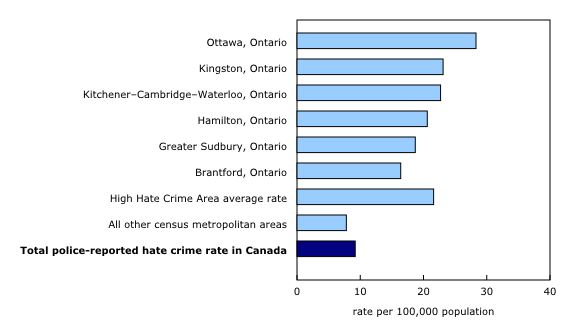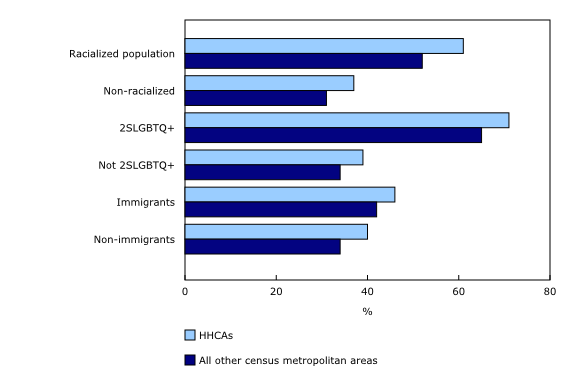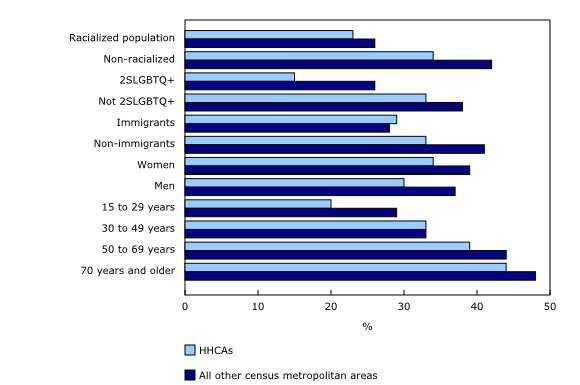Areas with high rates of hate crime also report lower scores on quality of life indicators
Released: 2024-02-08
The total number of hate crimes reported to police in Canada has risen to its highest ever, with 3,576 incidents reported to police in 2022. Hate crimes affect more than just the individuals who experience them. Communities that identify with the individual may feel vulnerable and fearful that they could be targeted next. Beyond the targeted population, the effects of hate crimes may also negatively impact social cohesion and sense of belonging for other people living in affected areas.
The total police-reported hate crime rate in 2022 across Canada was 9.2 incidents per 100,000 population, almost double the rate of 5.2 in 2019. The increasing trend in the number of hate crimes in Canada has provoked interest in exploring the social impacts and trends possibly associated with hate crimes. This study examines the Quality of Life Framework of Canadians living in cities where rates of hate crime are the highest.
This analysis uses census metropolitan areas (CMAs) where hate crime rates (per 100,000 population, in 2022) were the highest compared with the rest of Canada (i.e., all other CMAs with hate crime data). The six areas with the highest hate crime rates were the Ontario cities of Brantford (16.4), Greater Sudbury (18.7), Hamilton (20.6), Kitchener–Cambridge–Waterloo (22.7), Kingston (23.1) and Ottawa (28.3). These are hereafter defined as areas with high hate crime rates or High Hate Crime Areas (HHCAs). Some differences between CMAs in reported rates of hate crime may be due in part to differences in hate crime unit compilation, resources and reporting, among other factors.
Areas with high hate crime rates have lower scores of self-reported physical and mental health
Canadians living in areas with high hate crime rates were less likely to report positive physical and mental health. In cities with high hate crime rates, fewer Canadians reported excellent or very good mental health (46%) compared with Canadians living in the rest of Canada (50%). Previous research has indicated that communities may experience fear or new vulnerabilities as a result of hate crime. Among Canadians living in a HHCA, 51% reported excellent or good physical health, whereas 54% of Canadians in the rest of Canada reported the same. Trends for other quality of life indicators only emerged once data were disaggregated further by demographic variables. Although there are plausible relationships between experiencing a hate crime and other quality of life indicators, whether a causal relationship exists in either direction remains to be established.
Fewer women and racialized people report positive mental health in cities with high hate crime rates
Individuals subjected to hate crimes based on their race, ethnicity, religion, or a similar characteristic may experience heightened psychological distress. This is because such incidents represent an assault on a fundamental part of the victim's personal identity.
Overall, at the community level, the percentage of people self-reporting positive mental health was lower among those living in a city that was a HHCA than those living in cities with lower rates of hate crime. This was true for both men and women. All told, 49% of men and 43% of women in HHCAs reported positive mental health, compared with 54% of men and 46% of women in cities with lower hate crime rates. It should be noted that regardless of hate crime rates, men were more likely to report positive mental health (54%) than women (44%).
In HHCA cities, racialized people were less likely to report positive mental health (44%) than non-racialized people (51%). On the other hand, in cities with relatively low rates of hate crime, racialized people were more likely to report positive mental health (51%) than non-racialized people (49%).
Experiences of discrimination are more common in high hate crime areas
While a hate crime is a criminal violation motivated by hate, discrimination is when a person or group acts in a way or makes a decision that treats a person or group badly based on a characteristic covered under the Canadian Human Rights Act. Discrimination differs from a hate crime in that it does not meet the criminal threshold and may not be reported to police. Among HHCA cities in Canada, 42% of Canadians reported experiencing discrimination at least once in the five years leading up to the COVID-19 pandemic and 18% reported at least one experience of discrimination since the start of the pandemic, in March 2020.
Over half (55%) of reported hate crimes in 2022 were motivated by race or ethnicity. Both racialized and non-racialized Canadians living in a HHCA city were more likely to report experiencing discrimination at least once in the five years leading up to the pandemic, compared with their counterparts living in a city with lower hate crime rates. In cities that were HHCAs, racialized people (61%) were more likely than non-racialized people (37%) to experience discrimination at least once in the five years leading up to the pandemic. Similarly, but to a lesser extent, 52% of racialized people in other cities reported experiencing discrimination at least once in the five years leading up to the pandemic, versus 31% of non-racialized Canadians.
In 2022, 14% of hate crimes were motivated by sexual orientation. Among Canadians who lived in a HHCA and who identified as part of the 2SLGBTQ+ community, 71% (figure should be used with caution because of the small sample size for this group) reported experiencing discrimination at least once in the five years leading up to the pandemic, compared with 39% of those who were not part of the 2SLGBTQ+ community.
Immigrants feel a strong sense of belonging to Canada regardless of hate crime rate
Sense of belonging to Canada is an important indicator of social cohesion and social integration for newcomers. Among all cities included in this study, 90% of respondents reported having a strong or somewhat strong sense of belonging to Canada. Immigrants feel a strong sense of belonging to Canada regardless of the hate crime rate in their area. A strong sense of belonging for immigrants has been a long-standing trend in Canada. In addition to immigrants, men and people over the age of 50 feel a notably stronger sense of belonging to Canada in HHCA cities than women and people of younger ages do.
In areas with higher hate crime rates, Canadians are less likely to know their neighbours
A key aspect of social cohesion is the desire to participate in the network of relationships within one's community—by definition, a cohesive society is an inclusive society. In HHCAs, 32% of Canadians reported that they know most or many of their neighbours. This percentage rose to 38% in other cities with lower rates of hate crime. This same trend—of being less likely to know one's neighbours in cities with higher hate crime rates—was observed across many sociodemographic characteristics, including those who identified as part of the 2SLGBTQ+ community and some age groups. In contrast, women, racialized Canadians and immigrants were nearly as likely to know their neighbours, regardless of whether their CMA had a high or low rate of hate crime.
In summary, in CMAs where higher rates of police-reported hate crimes were recorded, poorer scores for multiple indicators of quality of life were also noted. This study did not measure whether poorer quality of life outcomes were a result of experiences related to hate crimes, or whether the indicators were measuring aspects of social fracture that led to conditions for hate crimes. Many of the social conditions within cities can have an impact on the rates of hate crimes.
Statistics Canada is committed to monitoring these social indicators for well-being through its Quality of Life Framework. In addition to looking at each indicator in isolation, the framework is useful in developing an understanding of the relationships between determinants of quality of life. Social indicators for well-being can be found on the Quality of Life Hub, an online portal for information and data related to the Quality of Life Framework. The Hub is currently in development, with additional quality of life indicators, data and visualization tools being added over time.
Did you know we have a mobile app?
Get timely access to data right at your fingertips by downloading the StatsCAN app, available for free on the App Store and on Google Play.
Note to readers
Police-reported hate crime data are drawn from the Uniform Crime Reporting (UCR) Survey, a census of all criminal incidents known to police services in Canada. For more information on the UCR Survey, key terminology and definitions, see Police-reported crime statistics in Canada, 2022.
Police data on hate crimes reflect only the incidents that come to the attention of police and are classified as hate crimes. Police determine whether a crime was motivated by hatred. They indicate the type of motivation based on information gathered during the investigation and common national guidelines for record classification. Hate crime counts include both confirmed and suspected hate crime incidents. Like other types of crime, counts of police-reported hate crime can be impacted by major social events, policing initiatives, or awareness campaigns.
This study used data from the 2020 General Social Survey on Social Identity that was collected from August 17, 2020, to February 7, 2021, and waves 2 to 7 of the Canadian Social Survey collected from August 2021 to December 2022 (pooled). In both surveys, the target population includes all non-institutionalized people and non-residents of First Nations reserves aged 15 years and older, living in the 10 provinces of Canada.
Contact information
For more information, or to enquire about the concepts, methods or data quality of this release, contact us (toll-free 1-800-263-1136; 514-283-8300; infostats@statcan.gc.ca) or Media Relations (statcan.mediahotline-ligneinfomedias.statcan@statcan.gc.ca).
- Date modified:



